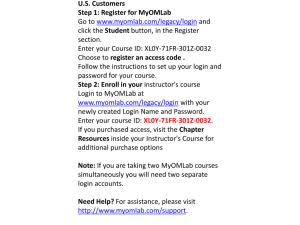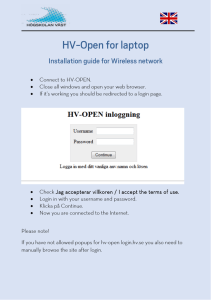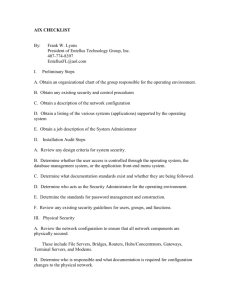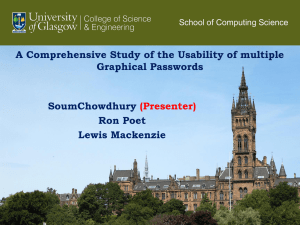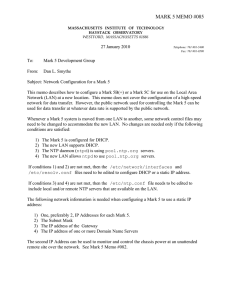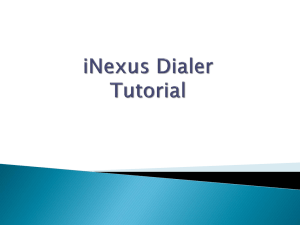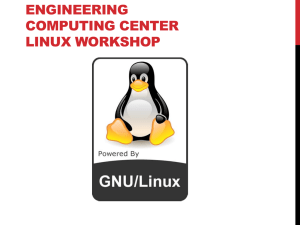lecture 3
advertisement
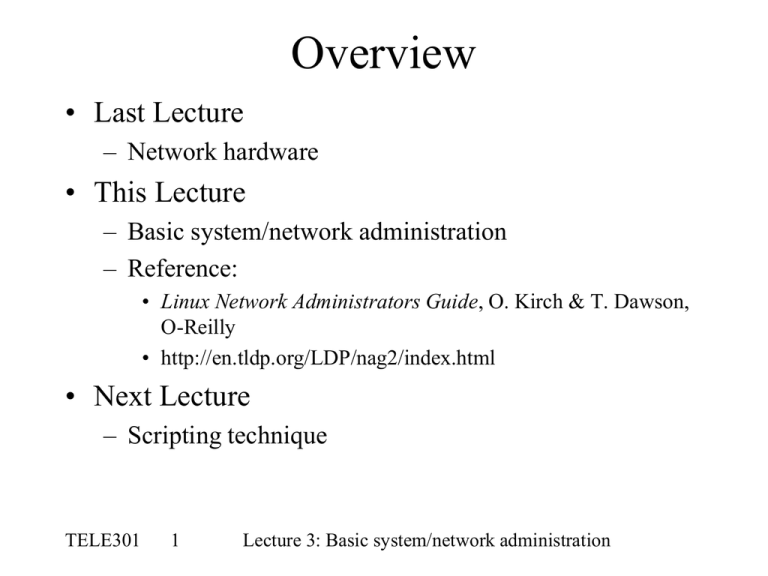
Overview
• Last Lecture
– Network hardware
• This Lecture
– Basic system/network administration
– Reference:
• Linux Network Administrators Guide, O. Kirch & T. Dawson,
O-Reilly
• http://en.tldp.org/LDP/nag2/index.html
• Next Lecture
– Scripting technique
TELE301
1
Lecture 3: Basic system/network administration
Security Awareness
• When a computer is connected to a network, it is
under potential attack!
• Physical network/machine protection
• Attacks are from the network and through servers
run by the computer
– Remove the services if you don’t need them
• Internet attacks
– Worms
– Viruses
– Denial of Service (DoS)
TELE301
2
Lecture 3: Basic system/network administration
Security Awareness (cont.)
• Computer/Internet hazards
–
–
–
–
–
–
–
–
–
SPAM/UCE (Unsolicited Commercial Email)
Phishing
Disk crashes/data loss
Loss of services due to outage
TCP/IP spoofing and sniffing (privacy)
Pornography
Ignorant users
Administrators of the untrained kind
…
TELE301
3
Lecture 3: Basic system/network administration
Roles in a Network Community
• To be a good system admin, you should be aware of the
roles in a network community and their strengths and
weaknesses.
• Important roles include users, hosts, and operating
systems.
– Users - should be trained to be aware of the community
– Host machines - should be allocated different tasks on different
server machines
– OS - have different pros and cons
• UNIX/Linux, Windows, MAC OS, Netware
TELE301
4
Lecture 3: Basic system/network administration
Network Administration
• Administration models
–
–
–
–
Reboot
Manual
Control
Immunology (self-maintenance)
• Network organisation
– Homogeneity/uniformity
– Delegation
• Principles of stable infrastructure
–
–
–
–
–
Scalability
Reliability
Redundancy
Homogeneity/uniformity
Reproducibility
TELE301
5
Lecture 3: Basic system/network administration
Network Administration (cont.)
• Virtual machine model (nothing to do with
VirtualBox or VMWare)
– Treat a network as a single virtual machine
– Good for resource management
• share software by NFS, shared printers, shared home dir.
• Automation for uniformity
– Script languages are helpful
• Revision control for configuration files
– Revision Control (SVN, git)
• Cloud model
TELE301
6
Lecture 3: Basic system/network administration
Network Kits
• Configuration tools
– ifconfig
– route
• How to find out info about your network?
– uname -a
– Find name server in /etc/resolv.conf
– Various configuration files such as /etc/services, /etc/inetd.conf
• Find out info about other domains
– dig or host
• If there is a problem from another domain
– Send email to postmaster@domain or webmaster@domain,
www@domain
– Use whois domain to get info about a domain
TELE301
7
Lecture 3: Basic system/network administration
Network Kits (cont.)
• Diagnostic/query tools
–
–
–
–
–
Wireshark
Ping
traceroute/tracepath
netstat
lsof
• Discover what you can do about a network
– nmap: scan a network for security holes.
• Proprietary network monitoring software
– E.g. from Cisco
TELE301
8
Lecture 3: Basic system/network administration
User Management
• User account
– Includes all the files, resources, and info belonging to
one user. For commercial systems, it may include
billing info.
• Create a new account
– adduser
– Account info: username, password, user id, group id,
full name of user, home directory, login shell
– Check after adding
TELE301
9
Lecture 3: Basic system/network administration
User Management (cont.)
• Password
– Very important for security
– Should not be names of persons, books, places, your computer, nor your
phone number, birthday, car registration plate, login name, words in
dictionaries, keyboard sequence
– Should be composed of letters (lower and upper cases), digits, and special
characters like $,@
– Refer to http://en.wikipedia.org/wiki/Password_strength
– passwd imposes similar rules to make passwords secure.
• User id and group id
– Users should be divided into groups for security reasons, e.g. students,
staff, admin
– Special users/groups: nobody, mail, ftp
TELE301
10
Lecture 3: Basic system/network administration
User Management (cont.)
• Involved files
– /etc/passwd, /etc/group, /etc/shadow
• User login environment
– .bash_profile, .bashrc, /etc/profile
– Place global files such as profile under /etc
• Other scripts can be referred in it
– Use env/set to check/set your environment
• Paths and prompts
– Keep a copy of your shell scripts (initial setups) in order to survive
them from upgrade of OS/software
• For more detailed info, man bash
TELE301
11
Lecture 3: Basic system/network administration
User Management (cont.)
• Remove a user: deluser
– The relevant lines from /etc/passwd, /etc/group, and /etc/shadow will be
removed.
– It is a good idea to first disable the account before you start removing stuff
• Disable a user temporarily
–
–
–
–
A better way when you are not sure if a user will come back
Way 1: Put an * in the password field of /etc/passwd or /etc/shadow
Way 2: use passwd -{l|u} username
Way 3: Change the login shell to a script file
TELE301
12
Lecture 3: Basic system/network administration
User Management (cont.)
• How to manage user accounts on different
computers?
– Share home directory using NFS
– Share passwords using NIS (Network Information
System) or LDAP (lightweight directory access
protocol)
– Allocate an Email server
– Directory services like LDAP
• How to remember different passwords for
different accounts on different computers?
TELE301
13
Lecture 3: Basic system/network administration
User Management (cont.)
• Control user resources
– Disk space
• Separate disk partition for problem users
– Use df command to monitor space
– Quotas and limits
• Better not to put them on users until necessary
• Check limits.conf under /etc/security
– Killing old processes
• Don’t do it unless you are absolutely sure
• Account policy
– Who shouldn’t have a user code?
– How to deal with weak passwords?
TELE301
14
Lecture 3: Basic system/network administration
User Management (cont.)
• User support services
– cshelp
• User training and well-being
• How to treat the users?
–
–
–
–
Your enemies?
Your friends?
Your co-operators?
…
TELE301
15
Lecture 3: Basic system/network administration
Least Privilege Principle
• No process or file should be given more privileges
than it needs to do its job.
• Setuid programs: don’t set unless necessary
• Run programs under special user id such as www
and nobody if possible
• Some applications such as httpd can change its
user id from root to nobody after opening the
privileged port number 80.
• Temporary files shouldn’t be in /tmp
TELE301
16
Lecture 3: Basic system/network administration
Keeping Time
• Time zone
• Showing and setting time
– date
– date -u: showing the universal time
– Get a time stamp: date +%y%m%d%H%M%S
• Hardware and software clocks
– Use date to update software clock
– Then use hwclock -w to set hardware clock
TELE301
17
Lecture 3: Basic system/network administration
Keeping Time (cont.)
• Time server
– Use some time server with accurate time
– netdate udp hostname will set the time of the current machine to
that of hostname (It seems netdate is not available now)
– Can automatically adjust time by putting the command in cron
table.
– Can also use NTP for more accuracy
• Network Time Protocol (NTP)
– Used to synchronize the time of a computer to another time server
or reference time source.
• ntpdate
– Accuracy: 1 ms to dozens of milliseconds
– Cryptography for security
– How does it work? For more details, please refer to
http://www.eecis.udel.edu/~ntp/ntp_spool/html/index.html
TELE301
18
Lecture 3: Basic system/network administration
Host Management
• Shutting down a host
–
–
–
–
Turn off the power?
Should use command shutdown
shutdown -h time halt the system. time can be now.
shutdown -r time reboot the system
• Log files and audits
– syslogd: a daemon for logging messages. Its configuration file is
/etc/syslog.conf
– dmesg: check kernel messages
– lastlog: check the last login time of every user
– syslog under /var/log: the log file of the system
– They should be rotated regularly
TELE301
19
Lecture 3: Basic system/network administration
Host Management (cont.)
• Making a file system (formatting)
– Formatting floppy: fdformat (low level format)
– make file systems: mkfs/mke2fs
• mkfs -t fstype filesystem
– Dump file system info: dumpe2fs
• Make a device
– mknod or /dev/MAKEDEV
– Make a device name in a file format so that you may be able to use
the device as a file
TELE301
20
Lecture 3: Basic system/network administration
Software Installation
• How to separate different third party software?
– One software per directory?
• GNU software structure
– lib, bin, sbin, etc, src
• GNU software installation
–
–
–
–
./configure
make
make -n install: before real installation.
make install
• Package management
– apt-get
TELE301
21
Lecture 3: Basic system/network administration

